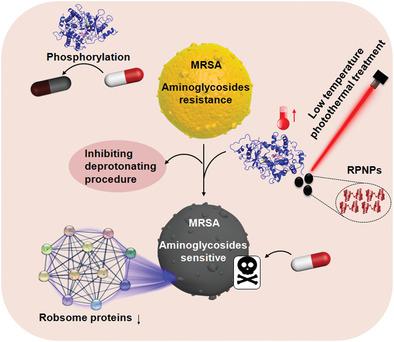Our official English website, www.x-mol.net, welcomes your
feedback! (Note: you will need to create a separate account there.)
Overcoming Multidrug-Resistant MRSA Using Conventional Aminoglycoside Antibiotics.
Advanced Science ( IF 14.3 ) Pub Date : 2020-03-14 , DOI: 10.1002/advs.201902070 Lei Tan 1 , Ziao Zhou 1 , Xiangmei Liu 1 , Jun Li 2 , Yufeng Zheng 3 , Zhenduo Cui 2 , Xianjin Yang 2 , Yanqin Liang 2 , Zhaoyang Li 2 , Xiaobo Feng 4 , Shengli Zhu 2 , Kelvin Wai Kwok Yeung 5 , Cao Yang 4 , Xianbao Wang 1 , Shuilin Wu 1, 2
Advanced Science ( IF 14.3 ) Pub Date : 2020-03-14 , DOI: 10.1002/advs.201902070 Lei Tan 1 , Ziao Zhou 1 , Xiangmei Liu 1 , Jun Li 2 , Yufeng Zheng 3 , Zhenduo Cui 2 , Xianjin Yang 2 , Yanqin Liang 2 , Zhaoyang Li 2 , Xiaobo Feng 4 , Shengli Zhu 2 , Kelvin Wai Kwok Yeung 5 , Cao Yang 4 , Xianbao Wang 1 , Shuilin Wu 1, 2
Affiliation

|
Global multidrug-resistant (MDR) bacteria are spreading rapidly and causing a great threat to human health due to the abuse of antibiotics. Determining how to resensitize MDR bacteria to conventional inefficient antibiotics is of extreme urgency. Here, a low-temperature photothermal treatment (PTT, 45 °C) is utilized with red phosphorus nanoparticles to resensitize methicillin-resistant Staphylococcus aureus (MRSA) to conventional aminoglycoside antibiotics. The antibacterial mechanism is studied by the proteomic technique and molecular dynamics (MD) simulation, which proves that the aminoglycoside antibiotics against MRSA can be selectively potentiated by low-temperature PTT. The catalytic activity of 2-aminoglycoside phosphotransferase (APH (2″))-a modifying enzyme-is demonstrated to be obviously inhibited via detecting the consumption of adenosine triphosphate (ATP) in the catalytic reaction. It is also found that the active site of aspartic acid (ASP) residues in APH (2″) is thermally unstable from the results of molecular dynamics simulation. Its catalytic ability is inhibited by preventing the deprotonating procedure for the target -OH of gentamycin. The combined therapy also exhibits great biocompatibility and successfully treats MRSA infections in vivo. This low-temperature PTT strategy has the potential to be an exogenous-modifying enzyme inhibitor for the treatment of MDR bacterial infection.
中文翻译:

使用传统氨基糖苷类抗生素克服多重耐药 MRSA。
由于抗生素的滥用,全球多重耐药菌(MDR)正在迅速蔓延,对人类健康造成巨大威胁。确定如何使耐多药细菌对传统低效抗生素重新敏感是极其紧迫的。在这里,利用红磷纳米颗粒进行低温光热处理(PTT,45°C),使耐甲氧西林金黄色葡萄球菌(MRSA)对传统氨基糖苷类抗生素重新敏感。通过蛋白质组学技术和分子动力学(MD)模拟研究其抗菌机制,证明低温PTT可以选择性地增强氨基糖苷类抗生素对MRSA的作用。通过检测催化反应中三磷酸腺苷(ATP)的消耗,证明修饰酶2-氨基糖苷磷酸转移酶(APH(2″))的催化活性受到明显抑制。分子动力学模拟结果还发现APH(2″)中天冬氨酸(ASP)残基的活性位点是热不稳定的。通过阻止庆大霉素靶标-OH的去质子化过程来抑制其催化能力。该联合疗法还表现出良好的生物相容性,并成功治疗体内 MRSA 感染。这种低温 PTT 策略有可能成为治疗 MDR 细菌感染的外源修饰酶抑制剂。
更新日期:2020-03-14
中文翻译:

使用传统氨基糖苷类抗生素克服多重耐药 MRSA。
由于抗生素的滥用,全球多重耐药菌(MDR)正在迅速蔓延,对人类健康造成巨大威胁。确定如何使耐多药细菌对传统低效抗生素重新敏感是极其紧迫的。在这里,利用红磷纳米颗粒进行低温光热处理(PTT,45°C),使耐甲氧西林金黄色葡萄球菌(MRSA)对传统氨基糖苷类抗生素重新敏感。通过蛋白质组学技术和分子动力学(MD)模拟研究其抗菌机制,证明低温PTT可以选择性地增强氨基糖苷类抗生素对MRSA的作用。通过检测催化反应中三磷酸腺苷(ATP)的消耗,证明修饰酶2-氨基糖苷磷酸转移酶(APH(2″))的催化活性受到明显抑制。分子动力学模拟结果还发现APH(2″)中天冬氨酸(ASP)残基的活性位点是热不稳定的。通过阻止庆大霉素靶标-OH的去质子化过程来抑制其催化能力。该联合疗法还表现出良好的生物相容性,并成功治疗体内 MRSA 感染。这种低温 PTT 策略有可能成为治疗 MDR 细菌感染的外源修饰酶抑制剂。









































 京公网安备 11010802027423号
京公网安备 11010802027423号